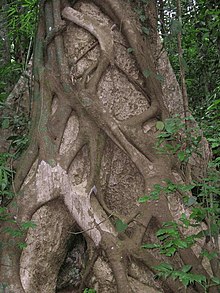


A hemiepiphyte is a plant that spends part of its life cycle as an epiphyte. The seeds of primary hemiepiphytes germinate in the canopy and initially live epiphytically. They send roots downward, and these roots eventually make contact with the ground. Secondary hemiepiphytes are root-climbers that begin as rooted vines growing upward from the forest floor, but later break their connection to the ground. When this happens, they may send down long roots to the ground.
Strangler figs are hemiepiphytic – they may begin life as epiphytes but after making contact with the ground they encircle their host tree and "strangle" it. This usually results in the death of the host tree, either through girdling or through competition for light. Strangler figs can also germinate and develop as independent trees, not reliant on the support of a host.
References
- ^ Mayo et al. "Araceae" in Kubitzki (1998b The families and genera of vascular plants): "The root climbers and hemiepiphytes normally grow in humid forests, often very high in the canopy. When losing connection with the forest floor, they may send down long roots to the ground; such plants may be referred to as secondary hemiepiphytes. Hemiepiphytes and root climbers cling tightly to the bark of the host with negatively phototropic roots. Skototropism, an orientation movement towards a well-defined dark area, has been observed in Monstera tenuis and other genera and is an adaptation in juvenile plants for seeking a suitable host tree, following germination on the forest floor."
- Kricher, John (2011). Tropical Ecology. Princeton University Press. pp. 101–102. ISBN 9780691115139.
- E. Putz, Francis; N. Michele Holbrook (June 1989). "Strangler Fig Rooting Habits and Nutrient Relations in the Llanos of Venezuela". American Journal of Botany. 76 (6): 781–788. doi:10.2307/2444534. JSTOR 2444534.
This botany article is a stub. You can help Misplaced Pages by expanding it. |